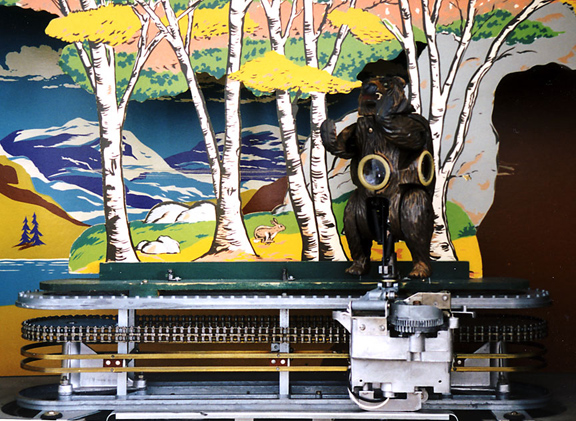(This is a reprint of an article I originally wrote for GameRoom Magazine.)
Contents:
Introduction
Play
General Description, Components
How It Works
History
Restoration Part 1
Restoration Part 2
Repair:
assembly steps
remove bear or dog
assemble bear or dog
adjust lamp duration

Introduction
"Every American should learn to shoot! Enjoy daily practice in safety on the Ray-o-lite Rifle Range!"
Operators! Capitalize on the mounting public interest in national defense! Capitalize on the patriotic appeal - on the thrill-appeal of realistic war action to men - women - children! Their enjoyment of this safe, instructive rifle practice means big money on all locations, everywhere, for alert operators.
(Quoted from Seeburg brochure)
Imagine a window into a forest. There is a small bear lurking in the woods, running in and out of the trees. You pick up your rifle and shoot. You miss because he is running so fast. You aim more carefully this time and try again. This time you hit him! He rears up on his hind legs and turns towards you, growling and howling. His eyes blaze bright and his mouth is full of teeth glowing a bright red. He turns the other direction and continues to run. You take aim again but this time your adrenaline is pumping and the rifle wavers. Will you be able to hit him again?
Do not forget your friends are all watching!

Play
There were many variations of the Ray-o-Lite rifle range. This description will focus on the Seeburg Shoot the Bear, produced from 1949 on.
The target cabinet is three feet tall by three and a half feet wide. It stands on chrome tubular legs or hangs on the wall. In the cabinet is a window about three feet wide by a foot and a half tall. There is forest scenery visible through the window. A small rabbit is hiding in the grass. There are some trees with gaps between them half way into the box. A small bear, about eight inches tall, is visible in front of the trees.
The gun stand is about 25 feet in front of the target cabinet. It consists of a cabinet with two coin slides, a rifle, one button and instructions.
The player puts in a quarter for three games or a dime for one. An amber light indicates there are credits to play. The user presses the button and the green light comes on, indicating the game is ready, and the bear starts moving. The player can pick up the rifle and shoot, with each game consisting of twenty shots. Every time the player pulls the trigger, a rifle crack sounds and the shot count goes down by one.
When the trigger is pulled, the rifle causes a light beam to shine out of the barrel. The bear has three lenses, on in each side and one in the front chest. Should the light beam strike the lens, the game will register a hit. Several things happen then. The bear stops running around the track and rears up on his hind legs. His eyes and mouth light up and he growls. He turns, gets back down on all four feet, and runs around the track in the opposite direction.
The number of hits is recorded in lights above the window and should the score be high enough, a rating is also displayed in lights under the window. The possible ratings are Marksman, Sharpshooter, and Expert.
References
Bueschel, Richarm M.: CollectorÃs Guide to Vintage Coin Machines, Atglen, PA: Shiffer Publishing Ltd., 1995
Keizer, J, L.W. Maki, J. Greathouse, G. Smith, and P.J. Bruinsma: Bistability and Fluctionations for an Incandescent Light Bulb, J. Physics Chemistry, 1995.
Kurtz, Bill: Arcade Treasures, Atglen, PA: Shiffer Publishing Ltd., 1994
Key Patent Numbers:
2,007,082
2,131,791
2,119,005
2,159,141
2,181,948
2,308,814
Acknowledgements and Thanks
Dennis Dodel, Sunset Hills, MO, traveler, for finding Shoot the Bear.
Chris Friedlander, Mt. Vernon, NY for sending me the first schematics and answering questions during the restoration.
Mark Kinsler, for endless email discussions on the actual physics of a light bulb and why they burn out.
Steve Blankenship for his flyers and lubrication chart
John Osborn for doing a subsequent restoration of another Rayolite system, thus making me check my information and be a bit more clear in my descriptions.
Author
Michael Sands is the proprietor of the Sands Mechanical Museum, a virtual museum on the Internet, www.sandsmuseum.com. Here you can find mechanical wonders like pinballs, coin operated machines, race cars, and antique clocks. Museum quality restoration services are also available. He lives in Sunnyvale, California with his wife and three children.
